Han Shi
Hong Kong University of Science and Technology
SheetDesigner: MLLM-Powered Spreadsheet Layout Generation with Rule-Based and Vision-Based Reflection
Sep 09, 2025Abstract:Spreadsheets are critical to data-centric tasks, with rich, structured layouts that enable efficient information transmission. Given the time and expertise required for manual spreadsheet layout design, there is an urgent need for automated solutions. However, existing automated layout models are ill-suited to spreadsheets, as they often (1) treat components as axis-aligned rectangles with continuous coordinates, overlooking the inherently discrete, grid-based structure of spreadsheets; and (2) neglect interrelated semantics, such as data dependencies and contextual links, unique to spreadsheets. In this paper, we first formalize the spreadsheet layout generation task, supported by a seven-criterion evaluation protocol and a dataset of 3,326 spreadsheets. We then introduce SheetDesigner, a zero-shot and training-free framework using Multimodal Large Language Models (MLLMs) that combines rule and vision reflection for component placement and content population. SheetDesigner outperforms five baselines by at least 22.6\%. We further find that through vision modality, MLLMs handle overlap and balance well but struggle with alignment, necessitates hybrid rule and visual reflection strategies. Our codes and data is available at Github.
Logits-Based Finetuning
May 30, 2025Abstract:The core of out-of-distribution (OOD) detection is to learn the in-distribution (ID) representation, which is distinguishable from OOD samples. Previous work applied recognition-based methods to learn the ID features, which tend to learn shortcuts instead of comprehensive representations. In this work, we find surprisingly that simply using reconstruction-based methods could boost the performance of OOD detection significantly. We deeply explore the main contributors of OOD detection and find that reconstruction-based pretext tasks have the potential to provide a generally applicable and efficacious prior, which benefits the model in learning intrinsic data distributions of the ID dataset. Specifically, we take Masked Image Modeling as a pretext task for our OOD detection framework (MOOD). Without bells and whistles, MOOD outperforms previous SOTA of one-class OOD detection by 5.7%, multi-class OOD detection by 3.0%, and near-distribution OOD detection by 2.1%. It even defeats the 10-shot-per-class outlier exposure OOD detection, although we do not include any OOD samples for our detection. Codes are available at https://github.com/JulietLJY/MOOD.
A Survey of Large Language Models in Mental Health Disorder Detection on Social Media
Apr 03, 2025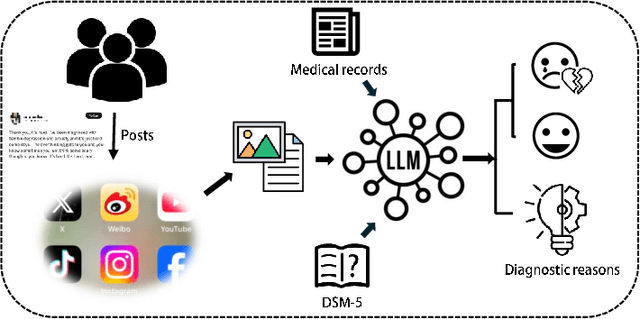
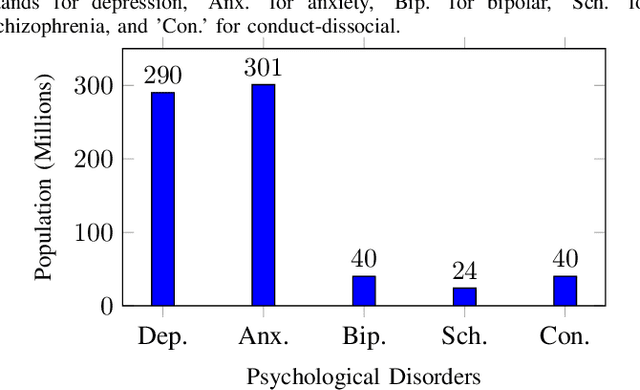
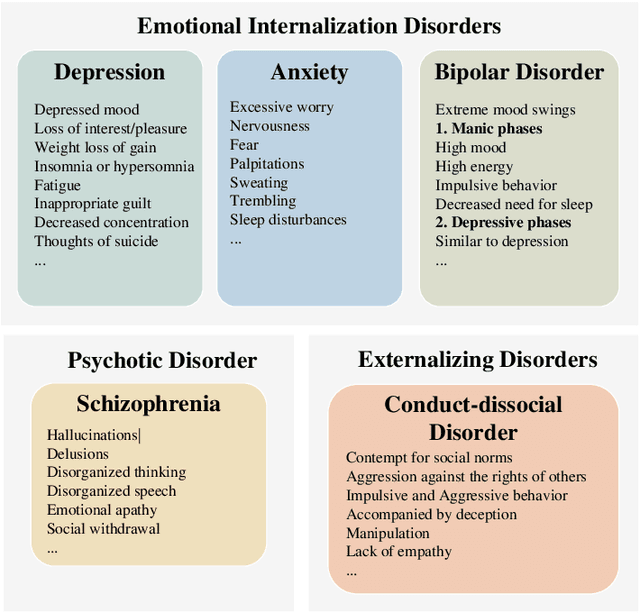
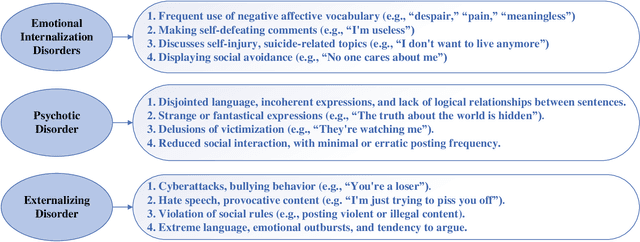
Abstract:The detection and intervention of mental health issues represent a critical global research focus, and social media data has been recognized as an important resource for mental health research. However, how to utilize Large Language Models (LLMs) for mental health problem detection on social media poses significant challenges. Hence, this paper aims to explore the potential of LLM applications in social media data analysis, focusing not only on the most common psychological disorders such as depression and anxiety but also incorporating psychotic disorders and externalizing disorders, summarizing the application methods of LLM from different dimensions, such as text data analysis and detection of mental disorders, and revealing the major challenges and shortcomings of current research. In addition, the paper provides an overview of popular datasets, and evaluation metrics. The survey in this paper provides a comprehensive frame of reference for researchers in the field of mental health, while demonstrating the great potential of LLMs in mental health detection to facilitate the further application of LLMs in future mental health interventions.
Self-Adjust Softmax
Feb 25, 2025Abstract:The softmax function is crucial in Transformer attention, which normalizes each row of the attention scores with summation to one, achieving superior performances over other alternative functions. However, the softmax function can face a gradient vanishing issue when some elements of the attention scores approach extreme values, such as probabilities close to one or zero. In this paper, we propose Self-Adjust Softmax (SA-Softmax) to address this issue by modifying $softmax(x)$ to $x \cdot softmax(x)$ and its normalized variant $\frac{(x - min(x_{\min},0))}{max(0,x_{max})-min(x_{min},0)} \cdot softmax(x)$. We theoretically show that SA-Softmax provides enhanced gradient properties compared to the vanilla softmax function. Moreover, SA-Softmax Attention can be seamlessly integrated into existing Transformer models to their attention mechanisms with minor adjustments. We conducted experiments to evaluate the empirical performance of Transformer models using SA-Softmax compared to the vanilla softmax function. These experiments, involving models with up to 2.7 billion parameters, are conducted across diverse datasets, language tasks, and positional encoding methods.
SepLLM: Accelerate Large Language Models by Compressing One Segment into One Separator
Dec 16, 2024



Abstract:Large Language Models (LLMs) have exhibited exceptional performance across a spectrum of natural language processing tasks. However, their substantial sizes pose considerable challenges, particularly in computational demands and inference speed, due to their quadratic complexity. In this work, we have identified a key pattern: certain seemingly meaningless special tokens (i.e., separators) contribute disproportionately to attention scores compared to semantically meaningful tokens. This observation suggests that information of the segments between these separator tokens can be effectively condensed into the separator tokens themselves without significant information loss. Guided by this insight, we introduce SepLLM, a plug-and-play framework that accelerates inference by compressing these segments and eliminating redundant tokens. Additionally, we implement efficient kernels for training acceleration. Experimental results across training-free, training-from-scratch, and post-training settings demonstrate SepLLM's effectiveness. Notably, using the Llama-3-8B backbone, SepLLM achieves over 50% reduction in KV cache on the GSM8K-CoT benchmark while maintaining comparable performance. Furthermore, in streaming settings, SepLLM effectively processes sequences of up to 4 million tokens or more while maintaining consistent language modeling capabilities.
Efficient Multi-modal Large Language Models via Visual Token Grouping
Nov 26, 2024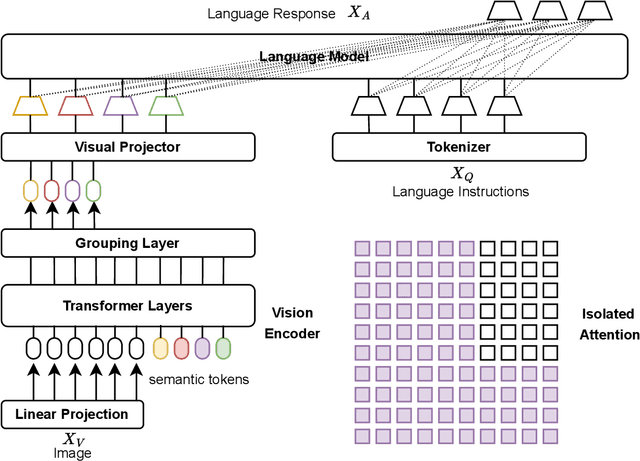
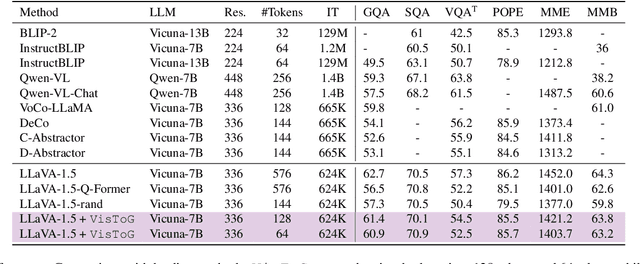
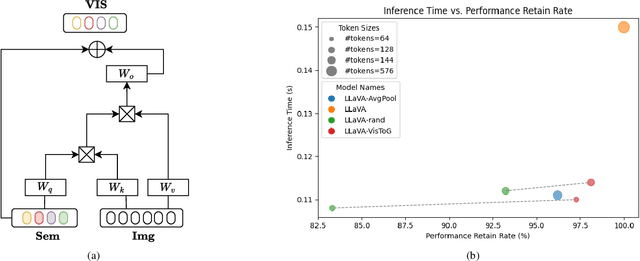

Abstract:The development of Multi-modal Large Language Models (MLLMs) enhances Large Language Models (LLMs) with the ability to perceive data formats beyond text, significantly advancing a range of downstream applications, such as visual question answering and image captioning. However, the substantial computational costs associated with processing high-resolution images and videos pose a barrier to their broader adoption. To address this challenge, compressing vision tokens in MLLMs has emerged as a promising approach to reduce inference costs. While existing methods conduct token reduction in the feature alignment phase. In this paper, we introduce VisToG, a novel grouping mechanism that leverages the capabilities of pre-trained vision encoders to group similar image segments without the need for segmentation masks. Specifically, we concatenate semantic tokens to represent image semantic segments after the linear projection layer before feeding into the vision encoder. Besides, with the isolated attention we adopt, VisToG can identify and eliminate redundant visual tokens utilizing the prior knowledge in the pre-trained vision encoder, which effectively reduces computational demands. Extensive experiments demonstrate the effectiveness of VisToG, maintaining 98.1% of the original performance while achieving a reduction of over 27\% inference time.
DAPE V2: Process Attention Score as Feature Map for Length Extrapolation
Oct 07, 2024



Abstract:The attention mechanism is a fundamental component of the Transformer model, contributing to interactions among distinct tokens, in contrast to earlier feed-forward neural networks. In general, the attention scores are determined simply by the key-query products. However, this work's occasional trial (combining DAPE and NoPE) of including additional MLPs on attention scores without position encoding indicates that the classical key-query multiplication may limit the performance of Transformers. In this work, we conceptualize attention as a feature map and apply the convolution operator (for neighboring attention scores across different heads) to mimic the processing methods in computer vision. Specifically, the main contribution of this paper is identifying and interpreting the Transformer length extrapolation problem as a result of the limited expressiveness of the naive query and key dot product, and we successfully translate the length extrapolation issue into a well-understood feature map processing problem. The novel insight, which can be adapted to various attention-related models, reveals that the current Transformer architecture has the potential for further evolution. Extensive experiments demonstrate that treating attention as a feature map and applying convolution as a processing method significantly enhances Transformer performance.
Accelerating Auto-regressive Text-to-Image Generation with Training-free Speculative Jacobi Decoding
Oct 02, 2024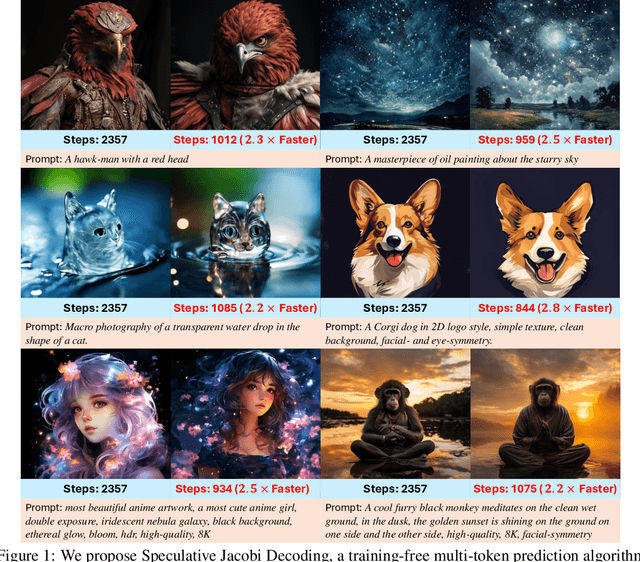
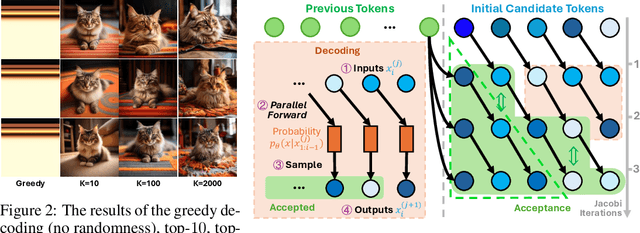
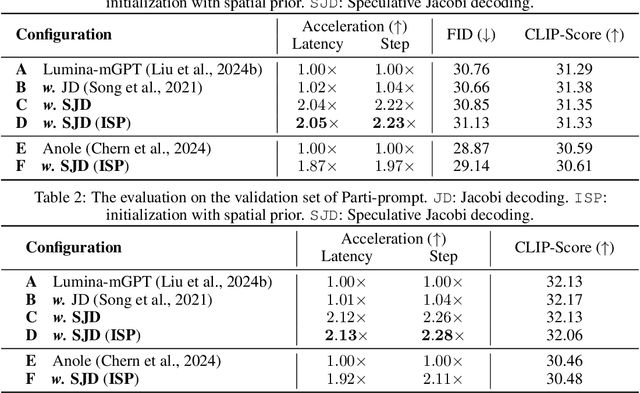
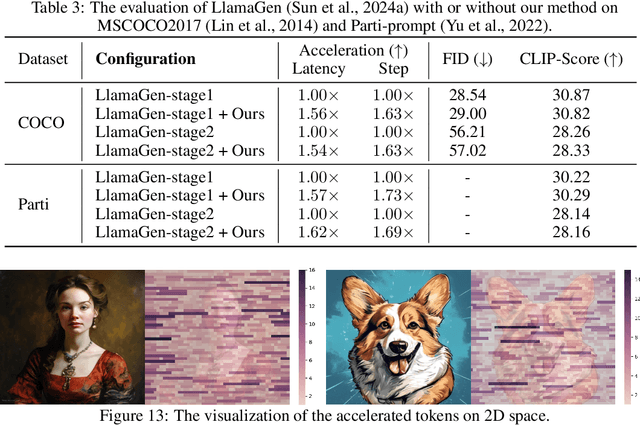
Abstract:The current large auto-regressive models can generate high-quality, high-resolution images, but these models require hundreds or even thousands of steps of next-token prediction during inference, resulting in substantial time consumption. In existing studies, Jacobi decoding, an iterative parallel decoding algorithm, has been used to accelerate the auto-regressive generation and can be executed without training. However, the Jacobi decoding relies on a deterministic criterion to determine the convergence of iterations. Thus, it works for greedy decoding but is incompatible with sampling-based decoding which is crucial for visual quality and diversity in the current auto-regressive text-to-image generation. In this paper, we propose a training-free probabilistic parallel decoding algorithm, Speculative Jacobi Decoding (SJD), to accelerate auto-regressive text-to-image generation. By introducing a probabilistic convergence criterion, our SJD accelerates the inference of auto-regressive text-to-image generation while maintaining the randomness in sampling-based token decoding and allowing the model to generate diverse images. Specifically, SJD facilitates the model to predict multiple tokens at each step and accepts tokens based on the probabilistic criterion, enabling the model to generate images with fewer steps than the conventional next-token-prediction paradigm. We also investigate the token initialization strategies that leverage the spatial locality of visual data to further improve the acceleration ratio under specific scenarios. We conduct experiments for our proposed SJD on multiple auto-regressive text-to-image generation models, showing the effectiveness of model acceleration without sacrificing the visual quality.
QuickLLaMA: Query-aware Inference Acceleration for Large Language Models
Jun 11, 2024Abstract:The capacity of Large Language Models (LLMs) to comprehend and reason over long contexts is pivotal for advancements in diverse fields. Yet, they still stuggle with capturing long-distance dependencies within sequences to deeply understand semantics. To address this issue, we introduce Query-aware Inference for LLMs (Q-LLM), a system designed to process extensive sequences akin to human cognition. By focusing on memory data relevant to a given query, Q-LLM can accurately capture pertinent information within a fixed window size and provide precise answers to queries. It doesn't require extra training and can be seamlessly integrated with any LLMs. Q-LLM using LLaMA3 (QuickLLaMA) can read Harry Potter within 30s and accurately answer the questions. Q-LLM improved by 7.17% compared to the current state-of-the-art on LLaMA3, and by 3.26% on Mistral on the $\infty$-bench. In the Needle-in-a-Haystack task, On widely recognized benchmarks, Q-LLM improved upon the current SOTA by 7.0% on Mistral and achieves 100% on LLaMA3. Our code can be found in https://github.com/dvlab-research/Q-LLM.
DiM: Diffusion Mamba for Efficient High-Resolution Image Synthesis
May 23, 2024



Abstract:Diffusion models have achieved great success in image generation, with the backbone evolving from U-Net to Vision Transformers. However, the computational cost of Transformers is quadratic to the number of tokens, leading to significant challenges when dealing with high-resolution images. In this work, we propose Diffusion Mamba (DiM), which combines the efficiency of Mamba, a sequence model based on State Space Models (SSM), with the expressive power of diffusion models for efficient high-resolution image synthesis. To address the challenge that Mamba cannot generalize to 2D signals, we make several architecture designs including multi-directional scans, learnable padding tokens at the end of each row and column, and lightweight local feature enhancement. Our DiM architecture achieves inference-time efficiency for high-resolution images. In addition, to further improve training efficiency for high-resolution image generation with DiM, we investigate ``weak-to-strong'' training strategy that pretrains DiM on low-resolution images ($256\times 256$) and then finetune it on high-resolution images ($512 \times 512$). We further explore training-free upsampling strategies to enable the model to generate higher-resolution images (e.g., $1024\times 1024$ and $1536\times 1536$) without further fine-tuning. Experiments demonstrate the effectiveness and efficiency of our DiM.
 Add to Chrome
Add to Chrome Add to Firefox
Add to Firefox Add to Edge
Add to Edge